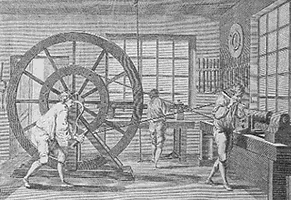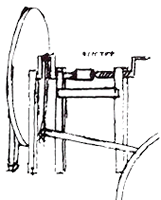
The wheel is probably man’s most important technological discovery. A Sumarian pictogram dated 3500BC is the earliest reference for the wheel. By 2000BC man was making spoked wheels yet the earliest pictorial reference we have of a wheel driven lathe seems to be from the 15th century.
The great advantage of a wheel driven lathe is that continuous and controlled rotary motion is possible.
This was not an automatic benefit to every aspect of woodturning though, as is illustrated by the continuing use of the reciprocating bow, strap and pole lathes. These ancient, simple lathes could still compete and perform efficiently in certain specialist areas such as small spindle and bowl turning.
Joseph Moxon (1683) put the wheel’s advantage as:
“Besides the commanding heavy work about, the wheel rids work faster off than the pole can do; because the springing up of the pole makes an intermission in the running about of the work, but with the wheel the work runs always the same way; so that the tool never be off it, unless it be to examine the work as it is doing”.

It is a drawing by Leonardo Da Vinci C.1480 that affords us our first glimpse of what an early treadle wheel lathe looked like.
The main eliminates required for self-propelled continuous rotation is clearly shown, the flywheel, crank and treadle. It was the crank in conjunction with the flywheel that provided a huge leap forward in technological advance. The crank, linked to a treadle provided constant rotation whilst the momentum of the large flywheel ensured the crank was carried over its ‘dead spot’. The drawing also shows an adjustable tailstock with a threaded cranked handle. Leonardo is often attributed to the invention of the wheel lathe but I think it is more likely he was sketching something quite well known in his time. Indeed I think it almost certain that the cranked wheel lathe was known in Roman times.
One disadvantage of Leonardo’s lathe is that it only provided direct drive, so the speed of the machine relies entirely on the speed of the turner’s foot on the treadle, but it is beautifully simple and compact with its integral wheel. The next advance was to mount the wheel independent of the headstock and linking the two via a belt or cord, this allowed the use of stepped pulleys to be used. With this arrangement a number of gear ratios were available and could be chosen simply by moving the drive belt from one stepped groove, either in the wheel, the headstock pulley or both to another.
John Jacob Holzzapffel writing in 1881 describes most beautifully the advantages of the wheel lathe as follows:
“Flywheels afford the lathe two important advantages. Their momentum, equalizes the results of the varying muscular effort expended in driving them; storing up all in excess for the work load to be overcome, and parting again with just so much, as is necessary to carry on an equal revolution under occasional increased strain, and during the recurring periods of diminished effort. Thus, permitting a maximum of power to be conveyed to the work, with a minimum of fatigue to the operator.”
The positioning of the wheel exercised the minds of many lathe users and builders over the following centuries. Joseph Moxon, in 1683 illustrates the wheel, contained in its own separate frame mounted on the floor beneath the lathe bed. In contrast Charles Plumier in 1701 depicts a French lathe with the drive wheel fixed in a frame to the wall above the lathe. The frame was raised or lowered by a wooden screw to enable adjustment to the drive belt .It is interesting to note the Plumier lathe incorporates a spring bow that could be used in conjunction with, or separately to the wheel.
Even though the foot treadle wheel lathe was a great advance, for many forms of turning it still had it’s limitations regarding the size of object to be turned. For heavy work the ‘great wheel’ was developed. These wheels were often six feet (2m) or more in diameter and were freestanding, usually being some distance from the lathe itself. The drive was a large cranked handle, sometimes one on each side. One or two men were employed in turning the ‘great wheel’ as required whilst the turner was left free to turn such items as large table legs, Lignum Vitae Wassail bowls or wheel hubs.
A Great wheel lathe was illustrated in a nice little woodcut published in the ‘Book of Trades’ published C.1568 in Germany by Jost Amman. It depicts a pewterers workshop open to the street as was often the custom in medieval times. The ‘wheel turner’ cranking the great wheel can clearly be seen as can the Pewterer forming vessels on the lathe.
Although we tend to think of early lathe turning as the production of essential domestic objects there were exceptions. The treadle wheel lathe provided some members of the aristocracy with a hobby that some found as absorbing as any modern day turner. This section of society was more consumed with ‘ornamental turning’ and vied with each other for the most lavishly equipped machines. Ornamental lathes were very special; they allowed both the cutting tool and the object to revolve independently and at the same time. There was great competition amongst royal family’s to create ever more intricate and fantastic objects from exotic materials. As early as the sixteenth century the Hapsburg emperors were keen hobby turners, in Russia Peter the Great (1672-1725) pursued it with a passion and in France Louis XVI (1774-1792) was a great exponent and patron.
The Jurra region of France has long been a centre of woodturning and they devised some very ingenious treadle wheel lathes. One example consists of an upright wooden frame housing a lightweight spoked wooden wheel of approximately three feet (1 metre) diameter above a small lathe bed. This C.19th century lathe was designed for the manufacture of small turnings in Boxwood and Ox bone. It can be seen at the Art Tournage and Culture museum near Lons Le Saunier.
Geared cogwheels are rarely found in early lathes but I have seen two exceptions, one in France, the other in Romania. Although not ‘wheel’ lathes as such, they embrace the use of metal gear wheels to enhance the continuos revolutions gained by one turn of a cranked hand opperrated handle. Both examples appear to be wheelwright’s lathes for the turning of hubs for wooden wheels and would require two people to operate them, the woodturner and the handle turner.
